In this article, we will teach you how to play the B guitar chord by covering, first, the most common finger shapes of the B Major followed by lesser used variations that add a special sound to this familiar chord.
The B major chord and the B Major key, in general, are many guitarists’ favorites. This is because you can play it in shapes that use open strings, barre chords, and a combination of both that adds up for very unique sounds.
Table of Contents
1. B Major – Barre (Most Common)
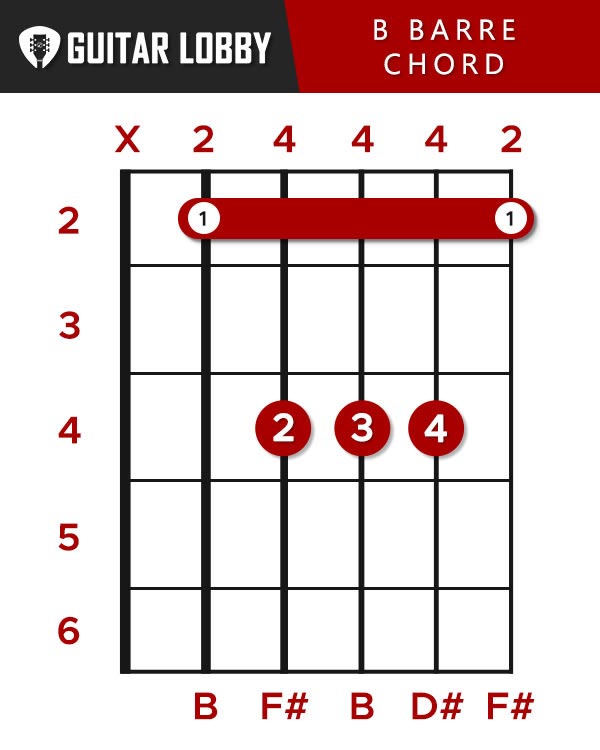
The most commonly used chord shape of B Major is the barre chord with a root on the 2nd fret of the A string. This particular shape and position make it easy to go from open chords, suppose A major, to B Major in an instant.
The first thing to keep in mind about barre chords is that, when playing them, the index finger takes the role of the guitar nut and holds down more than 1 string. If you are new to the concept then these shapes can be a small challenge, but nothing that cannot be overcome with some practice. The tricky part is getting the barre right and heaving all the notes ring out, but you will find it easier than expected with the help of some tips listed below.
There are 2 ways to play this B major shape. For the first shape, use the following fingering:
- Put your first finger (index) on the 2nd fret of the A string as a barre, holding down the A, D, G, B, and E string.
- Put your second finger (middle) on the 4th fret of the D String
- Put your third finger (ring) on the 4th fret of the G string.
- Put your fourth finger (pinky) on the 4th of the B string.
- Strum gently and make sure all of the notes ring out
Try to think about this fingering like this. Imagine an A major chord and take that shape 2 frets up the neck, then visualize your index finger in the role of a capo and place it firmly on the second fret while fingering the A major shape with the other 3 fingers. You’ve moved all of the notes in an open A major chord up 2 frets, or 1 full step (each fret is a half step), from an A chord to a B guitar chord.
The advantage of this shape is that all strings, inducing the high E, ring out. On the downside, having your 3 fingers compressed in the 4th fret can be a bit tricky. Especially the 4th fret of the D string is a bit challenging since your finger is forced to stay not as close to the fret as you would normally place it.
The second fingering of this shape is probably easier for most beginner guitarists.
- Put your index finger on the 2nd fret of the A string
- Put your ring finger or pinky, depending on what feels best for you, as a barre on the 4th freet for the D, G, and B string
- Play softly all the strings and check for buzzes
This type of barre with your ring or pinky requires a bit of strength to get right, but it’s usually a faster way to grab the chord shape and also it’s easier to get the chord clean and avoid the 3 finger cluster on the 4th fret.
On the downside, however, it’s easy to accidentally block the high E string with your ring finger barre. But the chord still sounds full and in some situations, you don’t need the high E string ringing out anyways.
For a better insight and detailed explanation of this chord shape have a look at this video:
Tips, Tricks, and Common Challenges
The challenge with any barre chord shape is to get the barre right and avoid putting a lot of pressure in your hand. These tips can help out a lot with both issues.
1. Hold your guitar like a classical guitar player
Place the guitar on your left leg (or right if you are a leftie) and hold the guitar neck up. This places the arm and hand in a more natural position and allows you to do bigger stretches with less pressure.
2. Carefully check the thumb positioning
The thumb position is the main element in getting all chords sound right on the guitar. Many players neglect how important placing your thumb can be. To get the B major chord right you should aim to place the thumb close to the center of the guitar neck. This assures that your handstands straight and the finger presses down with enough power to barre.
3. Mute the E string
Use the tip of your index finger to lightly touch the Low E string. This way you make sure you don’t have any unwanted sounds when strumming.
Expert Insight
If you can, try to hold this B major chord shape with either the first fingering or by barring the ring finger. This way your pinky is free to play around with some extended chord shapes we will learn in another lesson.
Brief Music Theory
All major chords follow the same formula of Root or 1st, 3rd, and 5th. These numbers correspond to notes from the B major scale.
The notes of the B major scale are
| B | C# | D# | E | F# | G# | A# |
| 1 | 2 | 3 | 4 | 5 | 6 | 7 |
The B major chord is formed from the notes B, D#, and F#.
Knowing the notes of the chord helps memorize the fretboard and find chord shapes more easily. Try to spell out loud, or sing if you can the notes of the B major chord. It’s a very rewarding exercise for guitarists of all levels.
2. B Major – Barre Alternative Fingering
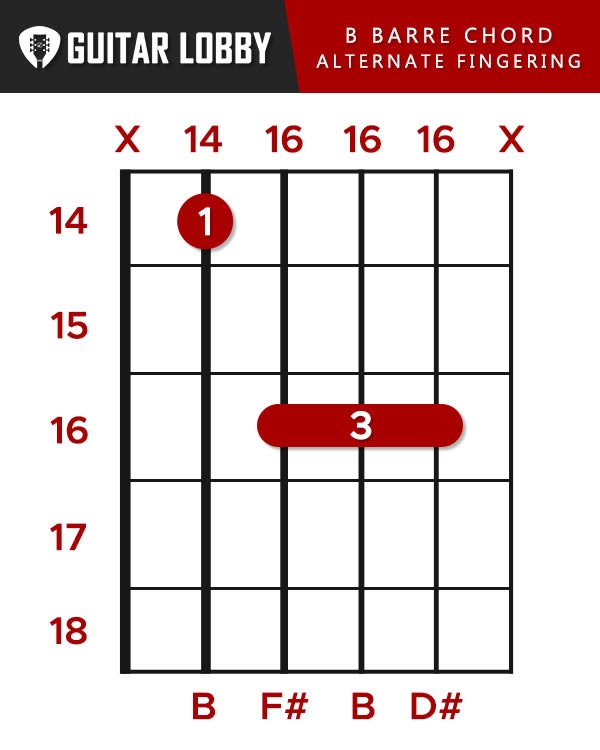
The B major chord can also be played in a higher octave. This variation of the B major is the same shape as the first chord we just learned but in a higher octave – that means 12 frets up the neck.
An alternative fingering for a B Barre chord is the following:
- Put your index finger on the 14th fret of the A string.
- Put your ring finger or pinky, depending on what feels best for you, as a barre on the 16tth fret of the D, G, and B string
3. B Major – Barre Variation 2
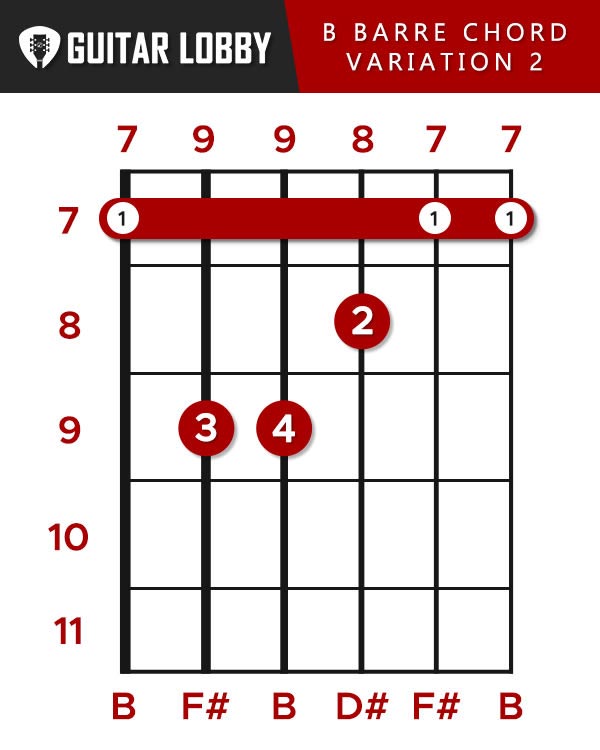
There are plenty of other ways to play the B major chord. Another B chord guitar shape with the root on the 7th fret on the E string.
The B Barre 2nd Variation fingering is as follows:
- Put your first finger (index) as a Barre on the 7th fret
- Put your second finger (middle) on the 8th fret of the G string
- Put your third finger (ring) on the 9th fret of the A string
- Put your fourth finger (pinky) on the 9th fret of the D string
- Strum with your right hand slowly and pick all strings to make sure all ring out
This chord shape is very useful to get a fuller guitar sound and also is used a lot if you are playing a series of barre chords. What makes it tougher than the previous shape is that it might require some more strength on the left hand to get the barre right.
Have a look at the video to see how the chord is formed and some help on getting it right
(Video 2 Coming Soon)
4. B Power Chord
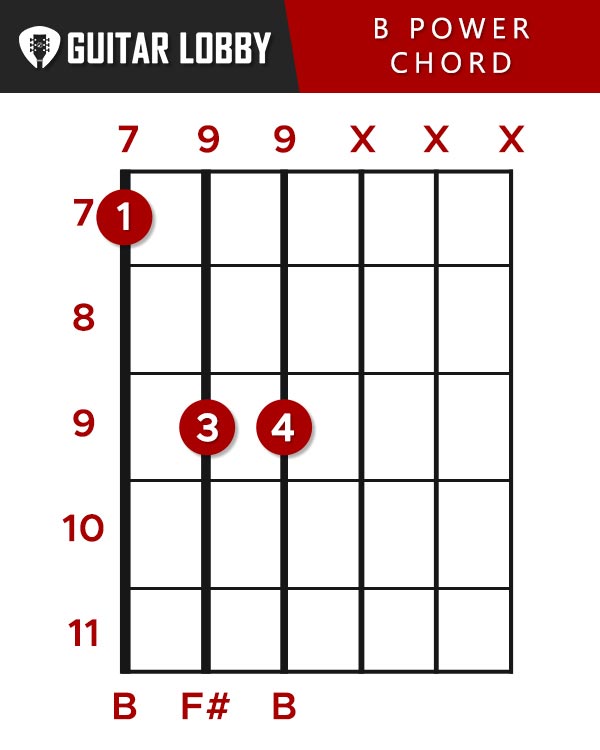
To play a B Power Chord:
- Place your first finger (index) on the 7th great of the E string.
- Place your third finger (ring)on the 9th fret of the A string.
- Place your fourth finger (pinky) on the 9th of the D string.
Power Chords are a common chord shape for Rock music. This B chord guitar shape very easy to play and sound great when played with a high gain tone on electric guitar. Power chords are not either major or minor, their nature depends on the context of the music and they work great in both situations.
Similar fingering to a Barre chord but without the “barre”, your index finger will simply play the root note. You’ll notice the B power chord, like all power chords, only plays the 1st and the 5th note of the key signature, dropping the 3rd note in the key signature as you would see in a Major Chord.
Have a look at the video to see how a power chord is formed and how to play one with ease.
(Video 3 Coming Soon)
Tips, Tricks, and Common Challenges
Always gently rest your index finger on the G, B, and E strings. This way you assure that you don’t have any unwanted sounds coming out of the chords.
Expert Insight
You can try the same concept of the B power chord on the A string. Try this as an exercise and try not to use a chord chart for this.
Find where the B note is on the A string and hold the same shape but in the B, D, and string. You will notice that moving the same shape you used on the E string will work out great on the A string.
5. B Major – Variation 1

One B Major chord variation that is relatively easy to play follows the following fingering:
- Put your first finger (index) as a barre on the 4th fret of the D, G, and B
- Put your fourth finger (pinky) on the 7th fret of the high E string
- Play only the D, G, B, and high E strings
This shape is perfect when you are playing along with a bass player or another guitar player playing a B Major chord because It does not have any bass notes (notes on the A or E string). If other instruments are playing the low notes then it’s probably better you don’t.
Another reason why this chord sounds very good is because of the high E string playing out the B note on the 7th fret. That added B note adds a lot of “flavor” and makes the chord sound “sweet.”
This more uncommon variation of the B Major chord is explained in detail in this video.
(Video 4 Coming Soon)
6. B Major – Variation 2
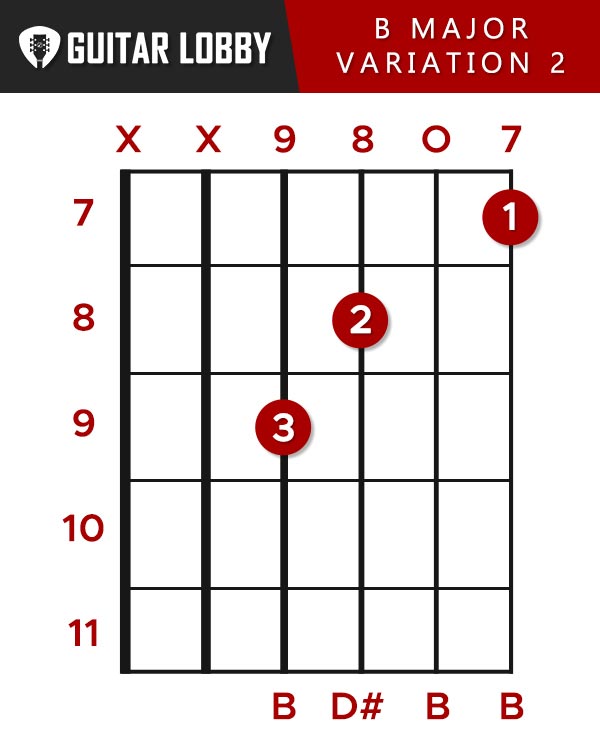
A very special variation of the B Major chord uses both notes from the barre chord shape and also the open B string. A second B Major Variation is played as follows:
- Place your third finger (ring) on the 9th fret of the D string.
- Place your second finger (middle) on the 8th fret of the G string.
- Place your first finger (index) on the 7th fret of the high E string.
- Leave the B string open and play the D, G, B, and high E strings.
This chord variation sounds very “bright” and “open”. The added open B string gives a natural sustain to the chord and makes for a very unique sound. Most guitarists rarely use these shapes, that’s why learning/playing it is so much fun!
Have a look at this video for a better understanding and to see this chord in action
(Video 5 Coming Soon)
Tips, Tricks, and Common Challenges
Keep in mind a very simple concept when playing B major chord variations. All variations (or sometimes called inversion) are playing the same 3 notes, the B, F#, and D# in different spots on the fretboard and also different strings per note.
For example, in some variations, the lower note (the note on the lower string) can be the B. In some other variation, the lower note can be the F#. Depending on this the chord will sound much different and give out a different vibe.
Expert Insight
Open strings are your friend! Whenever you can play an open string as part of a chord you should try it out.
Guitars, especially acoustics, resonate better when open strings are played and have more natural sustain giving out an almost “dreamy” tone. So, if you are playing an E, A, G, D, B, or E chord, try to add the open string that corresponds to the name of the chord.
7. CAGED B Major Chords
The caged system is a method used by many guitar players to organize the fretboard and play each chord in 5 different shapes. The shapes or those of C, A, G, E, and D open chords.
The system takes these shapes and changes the root note to different positions on the fretboard. So with the help of a capo, you can shift the key of your guitar and play a B Major chord using the same finger shapes that you have learned to play the chords C, A, G, E, and D when there is no capo on the guitar. The image below depicts 5 ways to play a B major chord using the CAGED method.
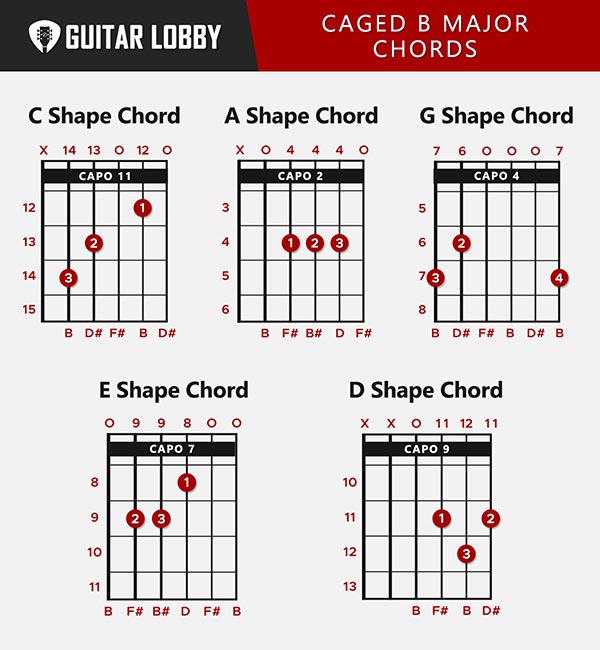
This concept can be tricky to grasp at first. Think of it like this, First, you have learned how to play the chords C, A, G, E, and D in standard tuning and have your fingers trained to make these 5 chord shapes. There is a location on the fretboard where you can play the same 5 finger shapes only it will be a B chord. It’s just a matter of where you need to use a capo so that you can play the open strings as well. For a better understanding of the Caged B Major chords, have a look at the video.
(Video 6 Coming Soon)
Tips, Tricks, and Common Challenges
The best way to visualize the CAGED B major chord is to imagine that you have a virtual CAPO that is placed anywhere that a B note is found in any of the strings.
For example, hold the D Major chord and notice that the root is on the open D string and the 3rd fret of the B string (both D notes). Now find where there is a B note is on the D string (9th fret) and where the B note is on the B string (12th fret). We see that we can find the B root notes up 9 frets, so we can shift all of the notes from an open D chord up 9 frets, hold the same shape but up in this new position, and we have a B chord using the same finger shape as an open D chord.
Expert Insight
A very good exercise is to visualize all the B notes on the fretboard and play the chord shape that is built around them. This proves to be a challenge even for intermediate players but is a skill that can be learned by all levels.
8. B7 Chord – Blues Chord

The B7 chord is probably one of the best sounding of all the 7th chords on the guitar and is widely used in many blues songs. The B7 fingering looks like this:
- Place your second finger (middle) on the 2nd fret of the A
- Place your first finger (index) on the 1st fret of the D
- Place your third finger (ring) on the 2nd fret of the G
- Leave the B string open
- Place your fourth finger (pinky) on the 2nd fret of the high E
- Play all 5 strings starting from the A down to the high E
This chord sounds very “tense” (just what we like in blues music!) and also very “open,” since you play an open B string too. The challenge is to not block the open B string and also to mute the Low E string.
The right thumb positioning, as explained above, can help you for the open B and regarding muting the E string, you can do that by gently touching it with the tip of your middle finger.
Have a look at the video for a bit more detailing on this cool sounding blues chord.
(Video 7 Coming Soon)
How To Play B Chord On Electric Guitar
If you are playing lead on electric guitar to make the chord sound good in the context of the music, sometimes you should not play the notes on the low E and A strings.
From the B major barre chord, apply only a small barre on the B and High E while holding down on the 8th fret of the G string. This is only half the chord but will work great with a clean guitar tone, especially if there is another guitarist or bass guitarist in your band’s mix. You can provide a more treble-driven “lead” tone.
On the other hand, if you are playing rhythm on electric guitar, Power Chords are a popular choice.
Final Tips on Playing the B Major chord
1. Learn more about the power of muting with the right hand
If you are playing an arpeggio with the notes of the B major chord or you are playing a B power chord you might try to rest gently your right hand on the bridge on the string you aren’t playing. This makes sure you don’t have any other string ring out.
2. Be mindful of pain in your arm or wrist
Some soreness in your fingers or wrist is normal for all beginner guitarists. However, if you are feeling pain in your arm or wrist you should consider your positioning and posture and consider adjusting.
3. Strum gently to avoid fret buzz.
When you are first learning a chord, pay attention to your strumming and make sure you aren’t strumming too hard. A lot of strength from the right hand can make the chords buzz, especially if you are just learning the chord. So just start playing softly at first and pick notes one by one to test out any new chord.
4. Three note chords are called triads.
Triads are like brokoli! Learning them is an essential skill to become an advanced player and they should be part of your daily practice routine.
5. The mixture of 2 different B chord shapes produces a better mix and unique tone.
If you are jamming with a friend or playing in a band make sure that you play a different chord shape that he/she is playing. For example, If he/she is playing a B power chord, which uses low notes, it may sound best if your B guitar chord utilizes some high notes with a shape that uses the B and high E strings.

My name is Chris and I’ve had a passion for music and guitars for as long as I can remember. I started this website with some of my friends who are musicians, music teachers, gear heads, and music enthusiasts so we could provide high-quality guitar and music-related content.
I’ve been playing guitar since I was 13 years old and am an avid collector. Amps, pedals, guitars, bass, drums, microphones, studio, and recording gear, I love it all.
I was born and raised in Western Pennsylvania. My background is in Electrical Engineering, earning a Bachelor’s degree from Youngstown State University. With my engineering experience, I’ve developed as a designer of guitar amplifiers and effects. A true passion of mine, I’ve designed, built, and repaired a wide range of guitar amps and electronics. Here at the Guitar Lobby, our aim is to share our passion for Music and gear with the rest of the music community.
